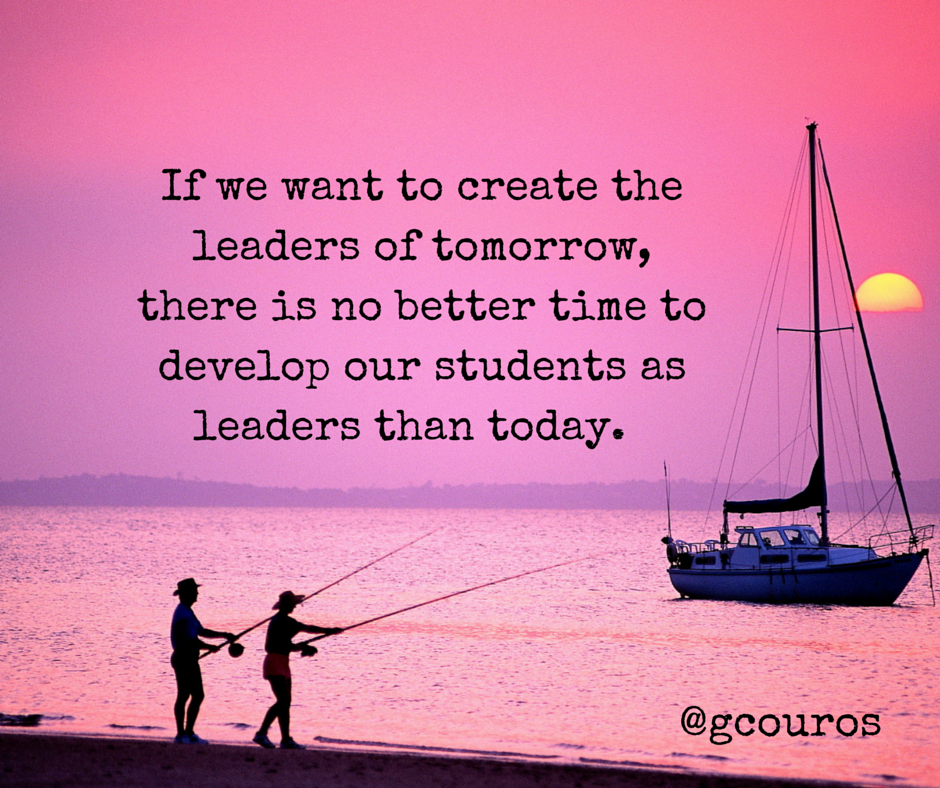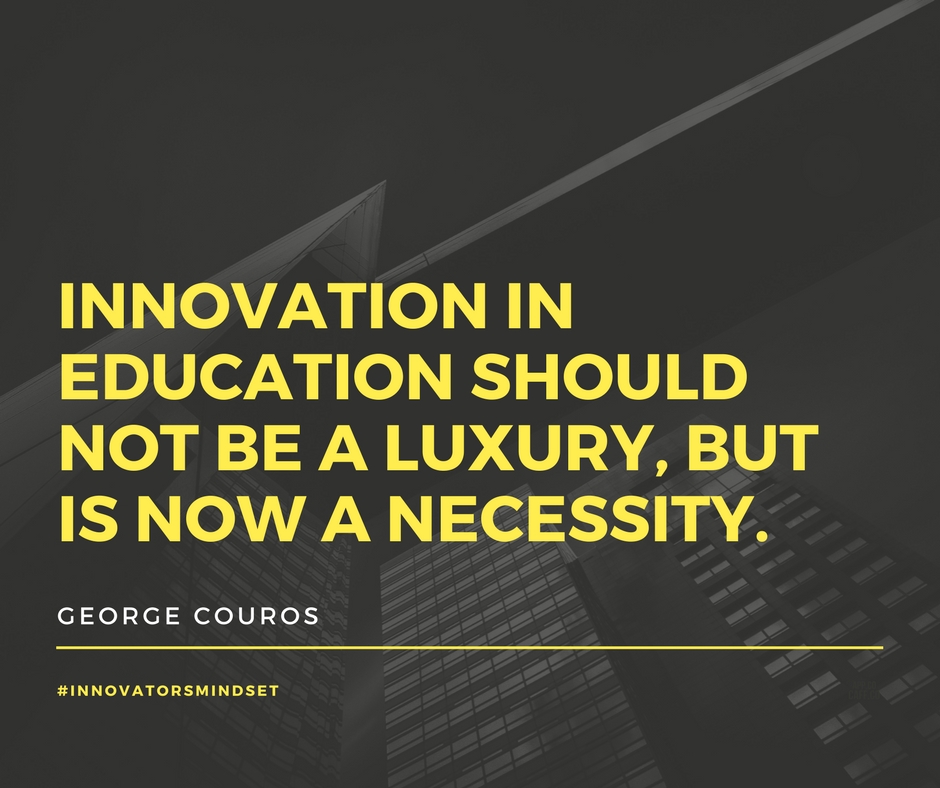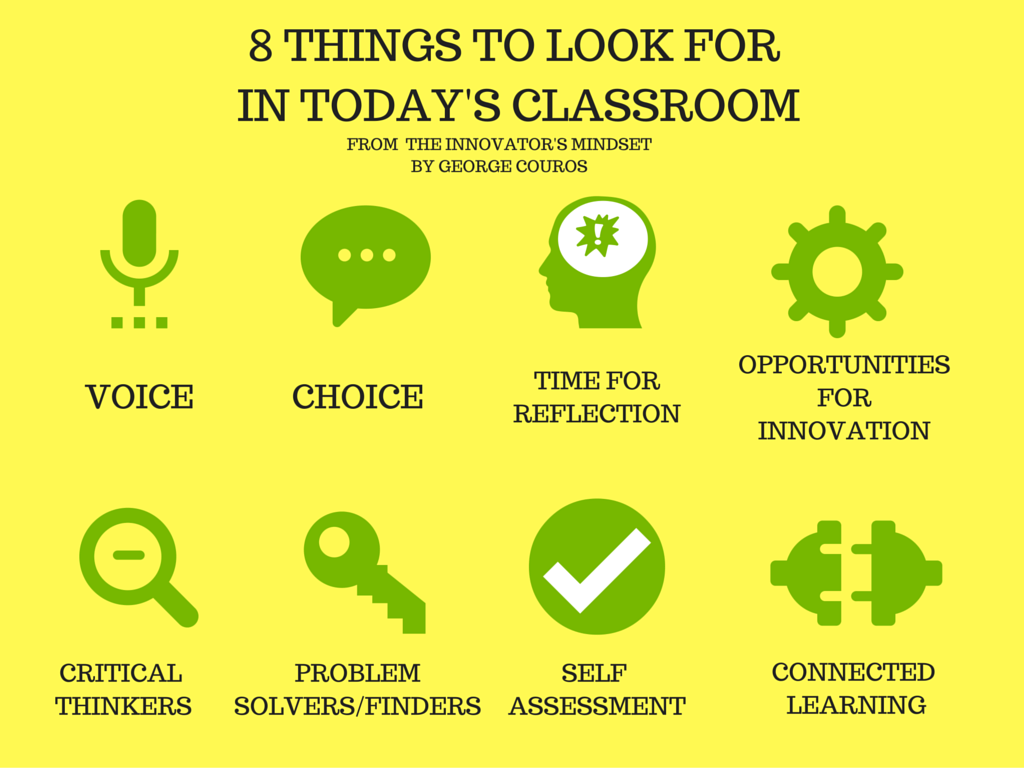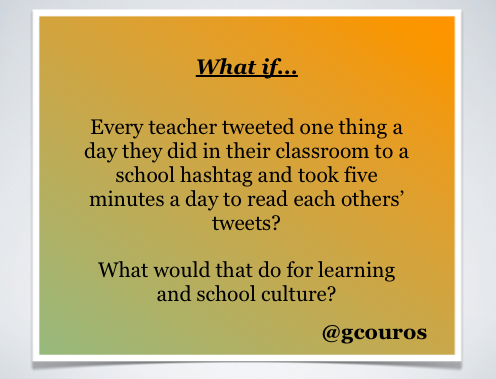 This is a compilation of some highlights in our second week of Innovator’s Mindset MOOC Round 2 #IMMOOC2. To join the conversation, check out IMMOOC.Org, #IMMOOC on Twitter, or join us on Facebook.
This is a compilation of some highlights in our second week of Innovator’s Mindset MOOC Round 2 #IMMOOC2. To join the conversation, check out IMMOOC.Org, #IMMOOC on Twitter, or join us on Facebook.
In Chapter 2 George states that the innovator’s mindset takes on the growth mindset. An example would be taking a “step further by focusing on using one’s ability to learn to play the piano to create music.” In education, he says we “must focus on creating something with the knowledge that’s been acquired.” He insists that this process requires resiliency, grit and the freedom to fail.
YouTube Live Episode 2 with George Couros, Katie Martin, and special guest, Sarah Thomas.
Share! Share! Share!
How do we get a culture of innovation in our schools?
The overarching theme in Live Episode 2 was the value of collaborating and sharing allowing us to be innovative. Sarah tells us to “Share! Share! Share!” The more we share the more input we get from others to refine and “shine like a diamond”. She saw the need for something new and better and launched Edumatch in 2014. She also found a need for people to grow in developing their “moonshot thinking” and created an actionable plan through “Designing with Passion”.
George adds that we will find more value following a hashtag that matches our interests rather than just searching for people on Twitter. It is through “competitive collaborative” support and pressure from one another that allows for innovative practices. He tells us that a foundation of trust, risk-taking and a culture of growth helps to launch innovative practices. Katie tells us that an innovative culture requires trust, space, support, modeling and accountability.
"You can't just take an idea and plop it into a school. It has to fit in with the culture." – @KatieMTLC Truth bombs from #IMMOOC pic.twitter.com/ra8jOvljHP
— Stephanie Filardo (@i3algebra) March 6, 2017
Reach for our Inner Fight Club!
How do we promote a culture where everyone is willing to take a risk?
Katie Martin reminds us that those with the best ideas aren’t necessarily coming from those that raise their hands first or are the loudest to be heard. What are we doing to allow the more introvert to share their innovative ideas? How are we breaking down barriers for them? Sarah brings on the great analogy with the movie, Fight Club, when she says that we have to project our confident alter ego to get stuff done; reach for our inner Fight Club.
Everything is in Beta Mode!
Innovation is about taking risks. Sarah reminds us that there are different types of risks and we must jump in “feet first” with our “moonshot” thinking rather than “head first”, but risks need to happen in order to keep moving forward. George tells us that innovation is not about creating something new, but doing something with what we created.
How do we know that our innovative idea is working? Sarah tells us the importance of documenting the journey as the best way to know how our “moonshot” idea is working. It is innovative if it is having an impact on students.
Here is a summary of the Live Episode 2 by Julie Johnson:
Thank you @gcouros @KatieMTLC & @sarahdateechur! Ready to work on my blog! #IMMOOC pic.twitter.com/DKzZO7Tsjk
— Julie Johnson (@JulieJohnsonja) March 6, 2017
Examples of innovation by #IMMOOC2 participants
The highlights in the blogs for this week included reflections, ideas and examples which can help us move forward in the innovative process.
Amy Busby reflects on how to take innovation from pockets to the norm.
So another question I ask myself is what experiences are we providing for teachers to allow them to learn and explore and collaborate with others in their profession? If we feel it is important, we must make time for it. We as leaders get bogged down in the compliance aspect of education as well. There are rules, requirements, policies, and assessments that can’t be ignored. But even with all of those expectations, we must model the innovation we want to see.
My hope is that one of the new adventures we started in our district, Montgomery Master Teachers, is encouraging that type of innovation. The teachers are encouraged to share their ideas with each other through a district Yammer page. We’ve had some take off with this collaboration and others who have been slow to get on board. There have been some great moments where the teachers have shared ideas they’ve done in class and borrowed from each other. They are currently doing a book study together and using Yammer to share their ideas and discuss the book together. So far, this has been a great tool. I look forward to seeing where the teachers take their learning.
Jeff Court sees innovation all around him as a principal who wants to “lead with passion, push the status quo, and support the work that keeps student learning at the fore front of my thoughts and actions”.
I have had the pleasure of witnessing a number of innovative practices occurring over the last year in our K-12 school with 325 students. I have witnessed teachers utilize SeeSaw as a self reflection tool and document learning for parents to witness their grade 2 students growth. I have engaged in creating high school courses that will empower grade 11 and 12 students to create, cover and mashup music that they love. High school students helping to develop a hot lunch program that now serves approximately 130 students a day. This program is literally students helping feed students. Elementary teachers that have stepped outside of their comfort zone to create flexible learning environments to meet the diverse needs of all of their students. Instruction, assessment and feedback for students has to change to meet the needs of all students in these new classroom environments. Each of these scenarios are great examples of teachers that have reflected on the needs of students and were willing to take a risk to create something new and better. Based on their professional journey, they are innovators that I will continue to support their efforts to create better opportunities for students.
Understanding those we serve
As we move forward in this Innovative Mindset practice it is important that we are impacting those we serve.
Keri Snowden adds a question we need to be asking ourselves as we make move forward with innovative practices and doing what is best for students.
What evidence of learning do we see in this student’s creation?For several years I have believed in the power of looking at student work in shifting a teacher’s focus from what they are doing to what their students are doing. This shift is important because I have known many teachers who think only about what and how they are teaching, how their day is going, how hard they are working, how busy and stressed they are, how frustrating or amazing their students can be. I have argued that looking at student work is what is needed to deepen PLC conversations and refocus teacher energy on the student experience. After all, it’s the student learning that is the purpose of our work.Now I feel the need to revise my mantra from “looking at student work” to “looking at student creations.” In a creation, a teacher would see not just facts or algorithms regurgitated onto a page, instead she would see synthesis, prioritization, and communication about a topic or concept. This tells us so much more about a student’s strengths and weaknesses, his “soft skills,” his depth of understanding, and his ability to share it with others.
When I sit back and think about it, this type of learning is amazing. Learning from 3 different people who were in 3 different places – awesome. Learning at a time that was convenient for me – even better. Getting to hear directly from experts – priceless.
This connection to experts and to people physically out of reach is now available to everyone with internet. Learning like this is not just for teachers and other professionals, but also for our students. Are we helping our students find new learning opportunities and ways to connect with experts?
George said, “Everyone has something to say. Everyone.” This came as a part of discussion about introverts. I enjoyed hearing Sarah explain how she is an introvert (like me!), but she has found new ways to share. Katie continued by pointing out that technology creates opportunities for our introverted and/or quieter students. It gives ALL students voices in (and out) of the classroom….
…We HAVE to make these opportunities available to all of our students. Are we giving students ways to ask questions, ways to share ideas, ways to reflect and to grow?
When Katie said, “If you don’t know your kids and what they need, the innovations are frivolous,” she helped remind us that innovation is meaningless without connections and relationships. George also talked about how time spent talking to a teacher is time he will get back tenfold because of the relationship he’s developing. This applies to everyone in our school buildings – students, teachers, administrators, etc.
New ideas might be “fun” or “interesting” to people who like to try new things (like many of us in #IMMOOC), but we all must remember that if they don’t connect with our students and improve learning, then we need to rethink them. Are we keeping our students and their goals in mind when trying new things? Do we take time to get to know our students and teachers as people?
Characteristics of Innovator’s Mindset
We have talked a lot about these 8 characteristics of the Innovator’s Mindset this week. Which one did you talk about the most?

Robin Young reminds us how being networked makes us better in the end rather than being on an island.
Networking has been crucial to my development as an Instructional Technology Specialist. Recently the 8th grade math teachers wanted me to present ideas for integrating technology into their classes. This is an area that I have struggled with for a while since my background is in history. I turned to social media for ideas. I posted on twitter and on a Google+ community that I belonged to and asked for ideas. Within a day I had enough ideas and several concrete examples that in the end I was very proud of the final product and the math teachers were happy with their training. If I had been isolated I would have drug out the same old ideas and tried to sell them again. Instead I was able to deliver some good ideas that have continued the conversation between us about technology integration. In fact I agreed today to help develop a minecraft review session for them. We are also in talks about trying out a BreakoutEdu game soon. Opportunities that would not have existed without my network of amazing folks.
Joe Robison challenges us to think about what we are asking students to do with the information they are obtaining.
The question of what students can do with the information they are obtaining is something we need to begin asking ourselves as educators. As my paradigm has changed over time, and the more I have developed a growth mindset, my philosophy about my students and the information they learn has changed. I had to ask myself, “why am I presenting this information to students?” If the answer was only to pass a test, either mine or a standardized one, then I realized I was doing my students a disservice. If all we are measuring is memorization and compliance, then we are not preparing our students to be future ready. It is important that we allow our students to use the information they are obtaining in practical ways. At the end of every unit or topic, I have started asking students to identify a problem they can solve with their new knowledge. This practice has become so much a part of what we do, that students now go into each lesson looking through the lens of problem solving. The process has now become one of students continually looking for problems to solve as they are introduced to new concepts. This concept is crucial to developing an innovative mindset in the classroom. As a teacher, your job is not to find problems for students to solve, but rather to create an environment where students look for problems to solve. This mentality is critical to not only having an innovative classroom, but also to fostering an innovative mindset in your students.
Week 2 #IMMOOC Twitter Chat
The theme this week revolved around WHY we all need the innovator’s mindset? Here are just a few of the top TWEETS from the #IMMOOC chat during this second week.
A3 educators need to innovate because every learner is different everyday just like the world around them #IMMOOC pic.twitter.com/IV3IpvORDr
— Mike Mohammad (@Mo_physics) March 9, 2017
A4: When we empower kids to explore and learn how to make and impact on the world, we inspire innovators. #IMMOOC pic.twitter.com/IpldFEVKb9
— Katie Martin (@KatieMTLC) March 9, 2017
A4 #IMMOOC We want our students to be the creators and the leaders of today, not only tomorrow. Need that to happen in classrooms.
— George Couros (@gcouros) March 9, 2017
A4 #IMMOOC When students have an innovator's mindset, sometimes they don't worry about limits. That can be a beautiful thing.
— Sarah Thomas (@sarahdateechur) March 9, 2017
George created a synopsis of this week’s #IMMOOC chat using Twitter Moments in this link.
Katie Martin was able to provide the whole Week 2 #IMMOOC Chat into two Storify links provided here for your review.
Examples of Participant Created Images of Favorite Quotes
This Storify link showcases some IMMOOC2 participant creations this week. These creations highlight phrases that had an impact on us. What seems to be the overarching theme that inspired us the most this week?
I leave you with an inspiring clip, “What Are You Waiting For” mentioned by AJ Bianco in his blog, “Do Something Amazing”.
“We need to move from a known to an unknown that is possibly better.” – George Couros
We are better together and in the end the students are the winners,
Valerie









